RETAIL FURNITURE HERITAGE
1800-2011
Retail Furniture Stories -Part 6
by Janet Holt-Johnstone
If you’re heading for the U.S. Upper Midwest, and if your scheduling doesn’t happen to include a visit to Minneapolis/ St. Paul, the twin cities, it should!
There’s history of all sorts waiting for you at the confluence of the Mississippi and Minnesota Rivers, from the early days of the Dakota nation and the military location of Fort Snelling in 1819. The Fort is close by St. Anthony Falls, the only waterfall on the Mississippi River, the source of power for sawmills, later flour mills that, in time, turned the area into a world-leading centre of flour production.
They are cities of “firsts”; the first public art gallery in the upper Midwest and the nation’s first basilica, Our Lady of Lourdes. The year 1948 kicked off native son Hubert Humphrey’s notable career when he was elected Mayor of Minneapolis.
He was one of the organizers of the Minnesota Democratic Farmer-Labour Party, and initiated the country’s first Fair Employment Practices ordinance. A delegate to the 1948 Democratic National Convention, Humphrey became a U.S. Senator that same year, later serving as Vice President under Lynden B. Johnson.
Gabberts - 1946
They are vibrant cities with citizens to match. Like entrepreneur and visionary Don Gabbert. Don was a distributor for U. S. Royal Tire in 1946, and opened his first store in downtown Minneapolis selling tires and appliances and, for a time, marine and boating equipment undoubtedly inspired by the area’s many lakes and waterways.
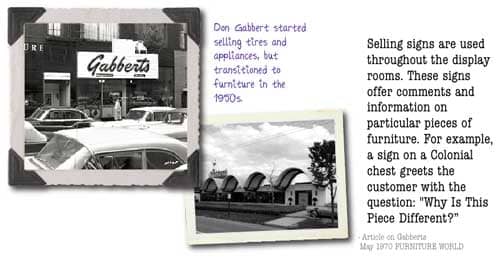
Don and his wife, Louise, went to California on holiday in the ‘50s. While there, they saw and admired well-made, maple Early American furniture. Don recognized the opportunity and was the first to jump on the brand new home furnishings bandwagon in the Upper Midwest. He closed his other stores and introduced with his new venture, two levels of furniture and accessories with a decreasing emphasis on appliances.
At the end of the decade, Gabberts opened the current Minnesota showroom in Edina, a suburb of Minneapolis. Again two levels, a total of 40,000 square feet, Don dedicated the lower level to what he described as a “smattering of furniture, Odds & Ends, where nothing is perfect, except the price”, and the “Garden Court”, a welcoming oasis for coffee and children’s playtime. It was an area heavily used during the long, chilly Minnesota winters. It was Don’s philosophy that shopping for home furnishings should be a “comfortable, enjoyable occasion for his guests”. To this day, The Coffee Shop continues to provide Gabberts’ associates with an opportunity to act as gracious hosts.
Gabberts made a display breakthrough at this point. During this era, most furniture dealers lined their furniture up like soldiers in mass displays, and only occasionally set up vignettes which they then roped off from customers. Don reached for more sophisticated visual merchandising. He wanted his “guests” to be able to visualize how the furniture would look in their own homes and almost all his inventory was vignetted and thoroughly accessorized. The new concept caught on and success demanded more space.
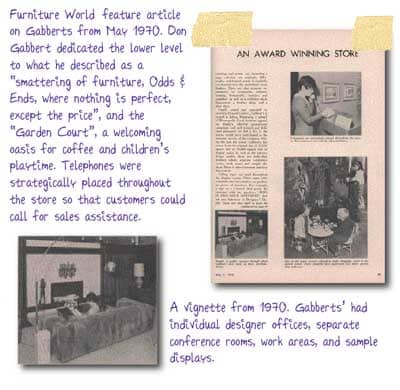
In 1962, the store was more than doubled in size to 92,000 square feet, with warehousing and furniture finishing on the lower level. The Garden Court was expanded and updated and the general office area within the store was relocated and enlarged.
By 1965, Gabberts desperately needed more warehouse space, and a separate distribution centre was built nearby.
The following year, they initiated the two price tagging system and discount pricing. Again, to this day, Gabberts has two prices. The tag shows both manufacturers’ suggested retail price, and Gabberts’ discounted price. By 1966, sales volume had risen to about $7,500,000 annually.
Don rose to Chairman of the Board in 1970, relinquishing his position as President to his son, John. His philosophy of “just one store in one location” continued. He was convinced that customers would drive the extra distance to see a large, diversified selection of furniture under one roof, and that satellite stores were inefficient and unnecessary.
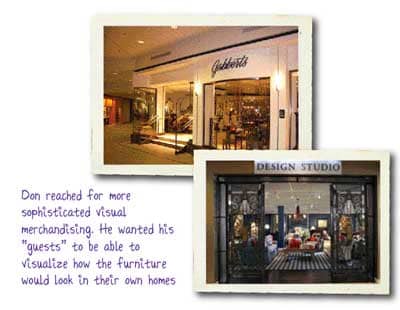
But by 1973, the winds of national expansion arrived at Gabberts’ threshold. The Minneapolis store’s sales were $12 million annually, and Don and John decided to duplicate their store in another major market, one with similar demographics. Dallas was chosen. Gabberts opened a 100,000 square foot store with an adjacent distribution centre. In the first half of that same year, Dallas recorded impressive sales figures.
The Gabbert family now purchased the complete tract of land on which the Minneapolis store was located. They established the Galleria Shopping Centre as a mall for “stores of distinction”. Today, with the Gabberts store as anchor, the Galleria is operated by Gabbert & Beck, the real estate division of the Gabbert family firm. In 1991, the expansion of the Galleria Mall increased Gabberts’ store to 104,000 square feet.
During the downturn in the economy in 1973-74, the Dallas store began to suffer reversals and, for the next few years, failed to reach many of the goals necessary to make it a contributing factor to overall company profits. The great potential of the Dallas market seemed to evaporate, in spite of the efforts of many loyal and talented associates.
But Don continued to have faith in Dallas despite the national recession. In 1980, he returned from semi-retirement to active duty within the company. John left to grow and expand the Room and Board furniture concept he had initially developed as a division of Gabberts. His brother, Jim, became President of the company. Don’s standards remained intact, offering superlative customer service, delivering honest value and elevating the role of good taste.
Many of the original company guidelines were re-instituted and refined in both markets with Don as advisor. Expenses were closely analyzed, product mix challenged, departments restored, inventories increased and a strong programme of advertising was resumed.
Sales in both stores were again brisk by 1984, with both markets generating around $2 million in sales monthly. Emphasis was placed on generating sales volume, but Don held to his vision that, “We are not only in the furniture business. We’re in the business of taking care of people”.
One year later, Gabberts Minneapolis added a Lighting Studio. Retail space was leased across the street and “outdoor”, the only category not represented in the parent store, was added; Gabberts was now a full service furniture store. Wicker, rattan and casual dining were also moved to this store which they named Gabberts Casual.
In Texas, Gabberts expanded their operation in May 1987 with a new 70,000 square foot store in Fort Worth. With the close proximity of Dallas and Fort Worth, Gabberts was able to utilize the same warehouse and some of the same media, yet reach a different customer.
The close of 1987 was the beginning of a new era for Gabberts. Jim and his oldest brother, Tom, bought the company from their father, Don. Jim became the CEO and Chairman of the Board.
The Gabberts were well aware that the decade of the ‘90s ushered in changes to the furniture industry at a pace never before experienced. On the fashion front they saw that eclecticism, or the practice of mixing design elements in the home, was becoming the rule rather than the exception. American lifestyles were turning casual, tossing off the constraints of formal décor. Industry analysts reasoned that consumers no longer wished to “live up” to their furniture, and feet-up comfort became the common fashion theme. And, last but not least, global sourcing was rapidly transforming the manufacturing landscape.
In 1991, an additional 45,000 square feet was added to the Minneapolis store, now 152,000 square feet. Gabbert Casual’s merchandise categories were incorporated into the new space.
In 1993, another addition was made to the Texas market, Gabberts Furniture Outlet just “one big Texas block from the main Dallas store”. Approximately 30,000 square feet, this showroom served as a clearance centre for discontinued, dropped, returned and special purchase merchandise. Ten years later, the Outlet moved to a larger location just north of the Dallas store.
In the year 2000, now 27 years young, Gabberts’ Dallas underwent a major facelift, a reinvention based on how customers shop. It was finished a year later and the result was a combination of convenience, fashion, drama and art.
The millennium brought pressures felt by most American retailers. “Rising costs of conducting business, competing consumer priorities and more competition in general, added up to diminished profitability and the need for well thought out business restructuring. At the core of this challenge, was the call for carefully focusing on real competitive strengths and fortification of brand image.”
Gabberts elected to resize its business to address the realities of market dynamics and to best leverage its long-standing equities following lengthy analysis of operating performance. The first major change was the decision to leave the Texas market.
Their attention turned next to the flagship store in Edina. In 2007, a major $5 million renovation was unveiled, improving store appearance and, most important, customer friendliness. They “listened to clientele” and created a showroom which was easier for “guests” to navigate with natural light and a “fresh buoyant atmosphere”.
Gabberts works with “about 200 furniture manufacturers and, if one adds in the resources for custom design work and specialty, the vendor count is over 2000. Our strength lies in the breadth and depth of the merchandise offerings, encompassing a range of styles and prices to meet the greatest variety of needs”.
Three years ago, Gabberts was acquired by Twin Cities-based HOM Furniture, the regional furnishings leader at the high-quality, moderately-priced level. HOM is a local and privately owned family-oriented business with a history of maintaining strong brands and a commitment to the communities it serves. HOM has brought to Gabberts a strong infrastructure, buying power, distribution networks and extensive service capabilities, helping Gabberts grow its “highest-quality” brand regionally.
In 2009, Gabberts celebrated not only the 50th anniversary of the Design Studio, but also its unique seminar programme for consumers. “Over the years customers have trusted Gabberts to provide professional guidance to make the most appropriate decisions in the interior design of their homes and office, casual enough for day-to-day living and elegant enough for formal entertaining. Relaxed enough to be Minnesotan, but elegant enough to be internationally cosmopolitan, a sophisticated blending of old and new, refined and primitive.”
Gabberts believes their “eureka moment” occurred when HOM Furniture acquired the company; “It has resulted in a strengthening of the brand. HOM cared deeply about the integrity of the brand and is not only perpetuating it but expanding it.” The strategy to grow the brand across the Upper Midwest was part of the acquisition plan. The new locations, Sioux Falls, SD and Sioux City, IA, will capitalize on HOM’s strengths and, utilizing the resources of Edina’s Design Studio, will afford a higher level of design services in these new markets. Grand Openings are planned for spring 2011.
During the transition to new ownership and the addition of Gabberts to the HOM Furniture portfolio of brands, it became critical to identify and protect Gabberts’ brand in order to maintain the legacy Don Gabbert established in 1946. It was a period of learning. “Concentrating on perpetuating the brand while also unifying the organization through processes, staffing and inventory systems, created confusion for the Gabberts’ associates who interpreted these necessary changes as possibly eroding the brand. On the core HOM Furniture side of the business, learning softer approaches, the importance of custom capabilities and longer selling cycles, were valued as passive approaches to the retailing market.
“Merging the talent of both staffs and the strength of both brands was a delicate dance where each partner needed to observe great care to avoid stepping on each other’s feet. There was no absence of growing pains during this process, and both brands have benefited greatly by the Gabberts acquisition.
“Ultimately, the decision to insulate and protect the Gabberts Brand became the single most important decision to move the brand forward. It enabled Gabberts to first stabilize, then grow, the retail sales to a pedestrian shopper while allowing resources to grow the distinct and specialized Design Studio portion of the business. Re-energizing the Gabberts Brand has allowed the vision of the founder, Don Gabbert, to continue support of the community during customer events, has attracted industry personalities to participate in intimate seminars for the consumer and for designers, and has enabled the company to participate with the design community.”
We asked the question, “What one issue, cause or policy stands out among all others that ensured the success of your business, benefited your customers and your community?” The answer, “When Gabberts was acquired, it was a defining moment for the brand, the retail store and the design studio. Making difficult decisions to eliminate staff, processes, overhead and changing the usual way of conducting business both externally and internally, were critical to profitability.
Dramatically reducing costs, saving quality people and increasing sales while making the effort to stay on brand, was a total team effort. Every department was affected, be it information systems, sales, operations, real estate, accounting and, of course, human resources. The effort became a rallying cry for cooperation in every department and on every level. Consistent scheduled meetings with both teams in every area, kept the new Gabberts moving towards a leaner, more focused company that ultimately put life back into the store.
“The institution, in 1959, of not only a design studio, but also a unique educational yet entertaining programme was Don Gabbert’s way of recognizing that, in order to serve his clients most fully, he needed to provide accredited, professional design advice and also help the client to develop confidence in their decisions based on honest and authentic sharing of information through seminars and workshops.
“Presentations and events are a very ‘soft sell’ opportunity. Gabberts has a unique position in the community and is known for sharing authoritative and entertaining information in a generous manner. We continue to feel that these are differentiating factors that help Gabberts maintain its leadership position in the home furnishings industry.”
“We see many opportunities to deliver Gabberts’ design expertise and product selection to more customers across the five-state Upper Midwest service area,” said Rod Johansen, HOM’s President and CEO. “We will continue to honour and leverage the 63 years of Gabberts brand heritage and an award-winning interior design team to markets currently underserved at the premium level.”
FURNITURELAND SOUTH
And here’s another dramatic “first”, and it happened only last year! The American Furniture Hall of Fame made the wise decision to induct Darrell and Stella Harris, the founders of Furnitureland South, the first time in the Foundation’s 22-year history that a couple had ever been nominated. Each fall the Foundation hosts a gala banquet during the October High Point Furniture Market to recognize the inductees, each of whom receives the “Affie”, the industry’s highest honour. They then become permanent members. In the presence of more than 400 industry leaders, Mr. and Mrs. Harris were praised for “the steady stream of innovations they’ve brought to the furniture shopping experience, for their emphasis on consumer value and for the many philanthropic projects they have supported”
Said Darrell in accepting the award, “We’re just blown away!” He attributed their achievement to “prayer and hard work”, then acknowledged his friends, family and employees. “I was told early in my career that you don’t have to be the smartest, you just had to hire the smartest team. And I was told you don’t have to be the best looking, so I hired and married the best looking woman!”
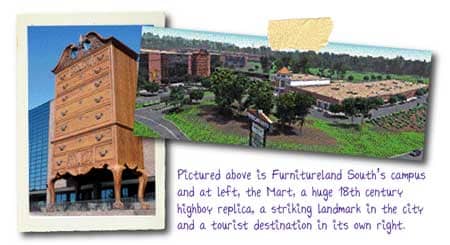
Stella’s remarks focused on three ideas: “Being blessed, thankful and the importance of relationships.” Modestly, she deflected credit for the honour, and insisted, “I don’t think we’re any more deserving than anyone else in this family business. I’m kind of the background person. Darrell is the visionary.”
So let’s go back a bit and retrace the Harris’s Odyssey. It all began in 1969, when endowed with a “big idea, an old truck, a few catalogues, some showroom samples”, two little boys and a lot of chutzpah, Stella and Darrell took their entrepreneurial first steps towards what was to become Furnitureland South, the largest and one of the most beautiful furniture showrooms in the world, more than 1.3 million square feet, truly a “destination” store, with more than 700 dedicated associates.
They could not have chosen a better location, right in the heart of the Piedmont Triad of North Carolina. Back in 1856, the city gathered itself together at the highest point of the North Carolina Railroad between Charlotte and Goldsboro where it intersected the 1852 Great Western Plank Road, a central location which allowed for the delivery of raw materials like cotton and lumber and processed goods in and out of the city, and contributed to its early growth. The area was settled before 1750 with a high proportion of Quakers and German immigrants who came in search of affordable land, good climate and an opportunity to create a principled and ordered community. High Point was incorporated in 1859, and the first of many High Point furniture factories was opened in 1889.
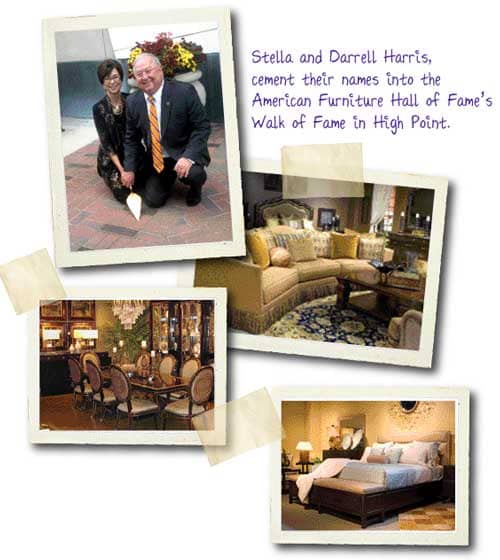
A university city since 1924, by 1969 High Point was beginning to diversify its economic reach and its growth included not only furniture, hosiery and yachts, but banking, photography and pharmaceuticals. It was in an atmosphere of cultural expansion and optimism that the Harris’s venture grew and prospered. By 1977 they built their first 17,000 square foot showroom. In 1980, they added 20,000 square feet to accommodate new gallery settings.
In 1990, Darrell made the bold decision “to move Furnitureland South away from Main Street, High Point where most furniture retailers were doing business, to its current location off Business 85. The new 228,000 square foot showroom offered significantly more display area.” This was the jumping off point, and “represents the beginning of dramatic growth for the company throughout the ‘90s. 1990 also marked the inauguration of a new era in the family business; sons Jason and Jeff became more involved after spending their childhoods mowing the company’s lawn, carrying out trash and moving “thousands of pieces of furniture” for their parents!
The campus continued to expand with the addition of the 500,000 square foot Mart in 1999, the state-of-the-art distribution centre in 2001 and, most recently, the newly redesigned and expanded Outlet Centre.
The Mart is a huge 18th century highboy replica, a striking landmark in the city and a tourist destination in its own right.
A “special time” in the history of Furnitureland was the opening of the “newly constructed 250,000 square foot distribution centre. Complete with an innovative rack system and pickers, this climate-controlled environment ensures that no two pieces of furniture touch, and the inventory is meticulously tracked, inspected and shipped. This innovation affords Furnitureland South the logistical capacity to receive and send furniture all over the world.”
The Harris’s have shipped to more than 50 countries and are staffed with International Sales and Design Consultants who assist with travel arrangements, lodging and local transportation. Plus product selection, interior design, space planning and measurement conversion, sales order documentation, commercial invoices and shipping authorizations and preparation of freight and forwarding charges. After all, it’s a global economy these days!
Much aware of the world’s need to sustain our environment, they unveiled an Eco-Friendly furniture gallery, the Eco-Link, a first (another one!) in High Point, NC. It is located in the glass-encased walkway that connects the Mart and the Showroom buildings. Furnitureland South made the decision to join the Sustainable Furnishing Council, and many of the manufacturers showcased in the Eco-Link are also members of the SFC. “The Eco-Link ‘links’ us to the earth and to our vendors who are embracing sustainable manufacturing processes,” said Jason Harris, now Executive Vice President of Furnitureland South. “This is a first step for our organization to publicly recognize that our earth needs a movement of people to save it for future generations. Our industry can have a huge impact on a problem that is not going away. We just want to do our part.”
The Eco-Link is an experience for shoppers they won’t quickly forget. “A few steps into the 400 foot glass encased walkway you know you’re somewhere special. The soothing sounds of water features and birds singing in the background mixed with the fresh scent of a Pacific breeze”... how do the Harris’s persuade their customers to go home?!
All the furniture shown in the Eco-Link has “green” properties. This is accomplished in several ways: harvesting and milling timber from the manufacturer’s own renewable forests; using timber from government certified forests; using “clean” paints and finishing products; using organic materials and fabrics; using recycled materials such as metal springs and using natural materials like water hyacinth.
From the beginning, Darrell Harris and his family have recognized the value of strong relationships with vendors, employees, customers and the community.
Establishing decades-long partnerships with manufacturers and positive relationships with employees and customers alike has been fundamental to Furnitureland South’s success. Equally rewarding are the opportunities for the Harris family and Furnitureland South employees to share their success with the local community through organizations like Habitat for Humanity, Brenner Children’s Hospital, Victory Junction and the Salvation Army.
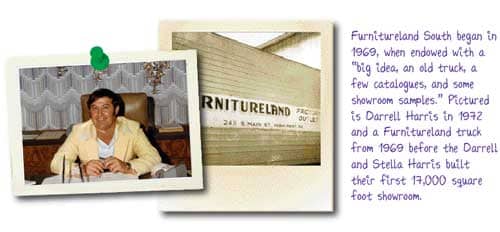
Not long ago they participated in an episode of ABC’s hit show, Extreme Makeover Home Edition in Loris, South Carolina. The episode featured the young Suggs family who “had just begun a family of their own when they took in Amanda’s six brothers and sisters to prevent them from being placed in a foster home”. Derrick Suggs, a police officer, had inherited a house built by his grandfather in 1953 with a leaking roof, rotting foundation, exposed electrical wiring and cracked asbestos siding. The team, along with racing legend, Jeff Gordon, several WWE wrestling stars and more than 2,000 local volunteers, built a new, safer home for the family in just seven days. And they invited
Furnitureland South to provide all the furniture and accessories required to make the house a home.
Sales and Design Consultant, Stephanie Portaro, with the assistance of the team, chose the furnishings in one afternoon; then Furnitureland South’s distribution and delivery teams went to work. Two days later, the truck pulled up to complete the home on time.
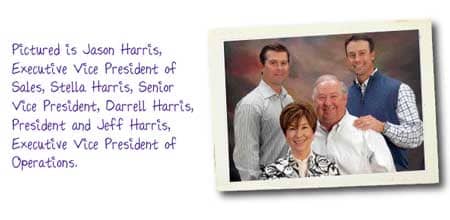
Stella Harris said she was glad for the opportunity to be involved. “We’re doing this because it’s part of our philosophy as a company. We like to help others. We’ve been very blessed to have the business that we do in these tough economic times, and we feel very blessed to be a part of this.”
A couple of years ago, they launched their “Dream Home” advertising campaign with a newly redesigned interactive website, and an endorsement deal with Jim Nantz, National Sportscaster of the Year. Also, Furnitureland South’s outlet centre was redesigned and expanded to 300,000 square feet. Take a look at their website, www.furniturelandsouth.com. Dazzling. And one asks, what does the future hold for the Harris’s? How many more “firsts”?
CITY FURNITURE
Entrepreneurs tend to create and/or attract “firsts”. Kevin Koenig’s vision took flight in the summer of 1971. With a brand new MBA from Florida Atlantic University, he worked in a small shop after graduation for a few weeks during his vacation in Provincetown, Massachusetts. By the time he travelled home to Fort Lauderdale, Kevin had saved $1,500, enough to launch his first venture. And, oddly enough, considering his focus, the first modern version of waterbeds was invented in San Francisco and coincidentally patented in (guess!) 1971.
The waterbed was originally created to enhance medical therapies in Scotland in the mid 1800s, and it was a full 100 years before Kevin’s forward thinking concept came on the scene. Mark Twain had described the benefits of waterbeds, “for invalids whose pains will not allow them to be on a less yielding substance”, this from The New York Times. But as the waterbed came into its own, so did Kevin.
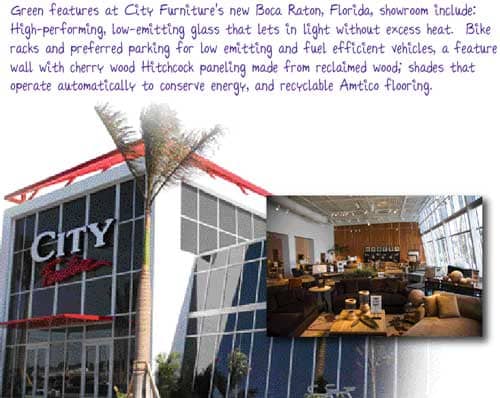
He called his first 800 square foot store, “Waterbed City”. Kevin hand cut and stained wooden mattress frames at night, and sold the completed product during daylight hours. He also felt a mission to educate his potential customers about the merits and benefits of his healthy lifestyle beds He advertised judiciously, his product was high quality and his customer service exemplary. Waterbed City soon outgrew its original size and he expanded to a 1,400 square foot showroom with a broader range of product offerings. More showrooms soon followed when Kevin, his brother Keith, and friends Mike Lennon, Garry Ikola and Steve Wilder formed a partnership. The team added “a more complete bedroom experience” with dressers, mirrors and nightstands.
In 1990, they realized that waterbeds had reached a consumer plateau, and the group quickly introduced innerspring mattresses to their stores. “The company exploded” and, a few short years later, Waterbed City evolved into City Furniture, offering not just bedroom furniture but a full line of home furnishings including living and dining room, wall units, home theatre and ready-to-assemble pieces.
City Furniture and Ashley Furniture Brands have been in partnership for more than 20 years, and they formalized their friendship in 2005 when City Furniture was selected to be the owner operator for Ashley HomeStores in South Florida.
Over the years City has opened eight Ashley HomeStores showrooms. Ashley has grown to be America’s “number one” home furnishings retailer with over 400 showrooms. They consider City a key partner, and are committed to build upon the successful relationship.
The dream that became the new Boca Raton superstore began its long march to reality in 2004. “It took seven years to secure the prime location we wanted on Airport Road, and two more to bring it to fruition,” said President Keith Koenig. “But it was worth the time. It’s the only location in Boca Raton that efficiently draws from both east and west communities. We’re 20 minutes away to well over one million people.”
The 93,680 square foot superstore represents an investment of $12-plus million. At the opening, Greater Boca Raton Chamber of Commerce CEO and President Troy McLellan said, “The Airport Authority finally got the right tenant!” Mayor Susan Whelchel, in conversation with Airport Authority Chairman Paul Carman, alluded to the length of time it had taken to “do the deal” and Carman joked about “getting a large check every month from their new tenant!” City Furniture’s ground lease with the Boca Raton Airport Authority will help support local economic growth, with rent going to enhance airport operations.
The new superstore, built by Stiles Construction and designed by architectural firm Garcia Stromberg, takes its inspiration in part from the neighboring Boca Raton Airport. Rooflines are unique and memorable, a wing-like roof defining the Ashley Furniture HomeStore, and a dramatic vaulted roof over City Furniture, recalling the shape of historic airplane hangars.
“This opening is truly about sustainability – both economic and environmental,” said Keith. “Our company’s roots are in South Florida, and we’re deeply committed to grow with and help sustain this region. We’re pleased to have generated more than 200 construction jobs, and to be adding about 50 new retail jobs as we launch the store’s operations.” Overall the company employs more than 800.
And, “about sustainability. Innovative and ‘green’ from its rooftop solar tubes for (natural) daylight harvesting, to its (dramatic suspended) LED track lighting inside and out, ‘building green’ is a natural extension of our corporate values and sustainable practices. Going forward, we’ll look to achieve LEED certification in every location where that’s doable,” Koenig said, noting that several new stores and renovations are on the boards for 2011 for the firm.
The building is one of just a handful of furniture stores nationwide that has been built to LEED standards, and the project team is seeking certification from the U.S. Green Building Council. The high-efficiency energy management system, heat-reducing features throughout and strategic use of natural light will conserve energy. Koenig believes the store should save about $30,000 a year on electricity as a result of some of its eco-friendly features. “When it comes to return on investment, it’s a slam dunk,” he said.
Distinctive interior décor has been achieved from reclaimed or recycled materials.
“Some of the visible design elements include a reclaimed cherry wall, slanted windows in the front of the structure with barely visible shades to protect the interior from the heat and light, and recyclable Shaw carpeting,” wrote Marci Shatzman of The Boca Raton Forum who attended the opening. “The store also includes irrigation and landscaping systems that use 78 per cent less water and even the urinals are designed to use 42 per cent less water. The company recycles all its furniture packaging and is phasing in green cleaning products.”
A statement in City’s website, www.cityfurniture.com, under “Our City Family”, defines Koenig’s attitude towards existing and potential associates. “Our company was started with the vision of an entrepreneur and each one of our associates are asked to run the business as if it were their own. Collectively we work for the common good of City Furniture and the customers we serve, driving the growth of our business. When the business grows, we all grow and prosper with it – and that’s a great thing.”
“Continuous learning and advancement” is encouraged with City’s Center for Excellence which is their “Corporate University”. It “offers you professional development opportunities ranging from a comprehensive new hire orientation program to on the job training programs specific for your position, to leadership development programs and much more. Our training programs consist of a blended learning approach comprised of computer-based learning modules and on the job training activities. We even offer an extensive learning library where you can select books and audio tapes to help you improve your knowledge and your skills.” Plus a “tuition reimbursement program” is also on board to help associates “earn your degree so that you can pursue other endeavors in the City Family”. The sky’s the limit!
Also a website feature, “Our Community”, reviews some of the charities, schools and other non-profit organizations supported by City’s team, and invites the browser to join them in “making a difference, giving back to the communities in which it does business”. A few, Habitat for Humanity, Holy Cross Hospital, City of Hope, World Harvest Missions Haiti, United Way, University of Florida and many others.
At the grand opening, red balloons were to be seen on 70 items in a silent auction. Koenig announced that 100 per cent of the proceeds would go to Hospice by the Sea, and the Adams Center for Entrepreneurship at Florida Atlantic University. Keith’s brother and business partner, Kevin Koenig, who died in 2001 at the age of 54, received care from the hospice and had a master’s degree from FAU’s business school.
It is not surprising that this high-spirited, lively corporate team felt moved to introduce fun to their showrooms. Customers are invited to enjoy fresh-baked cookies and hot coffee while strolling through their showrooms, and to bring their children to enjoy the experience. Interactive video games and the latest music videos are provided to keep them busy and entertained!